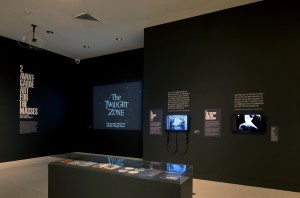
Rod Serling and Ernie Kovacs, two of television’s greatest impresarios, were especially attuned to modernism, integrating Dada, Surrealism, and other experimental sensibilities into their work. Serling’s groundbreaking The Twilight Zone and Kovacs’s conceptually and technologically innovative TV series and specials reveal a nuanced understanding of modernist aesthetics. Neither Serling’s nor Kovacs’s interest in modern art was simply stylistic. Both embraced avant-garde ideas that broached broad social or cultural issues—from the politics of the Cold War to the corporate ambitions of the networks themselves. In the end, their work was artful and sophisticated, exemplifying the best of early television.
(Above) installation view, Revolution of the Eye, NSU Art Museum Fort Lauderdale, October 2015. Courtesy of NSU Art Museum